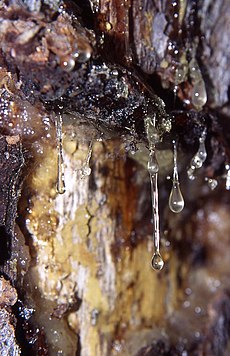Terpene: Difference between revisions
Pat Palmer (talk | contribs) (WP Attribution) |
mNo edit summary |
||
| Line 62: | Line 62: | ||
</references> | </references> | ||
</small> | </small> | ||
[[Category:Suggestion Bot Tag]] | |||
Latest revision as of 16:01, 25 October 2024

Terpenes are a large and varied class of hydrocarbons produced by a wide variety of plants and some mushrooms. Terpenes consist of compounds with the formula (C5H8)n for n ≥ 2. Terpenes are major biosynthetic building blocks. Comprising more than 30,000 compounds, these unsaturated hydrocarbons are produced predominantly by plants, particularly conifers.[1][2] In plants, terpenes and terpenoids are important mediators of ecological interactions, while some insects use some terpenes as a form of defense. Other functions of terpenoids include cell growth modulation and plant elongation, light harvesting and photoprotection, and membrane permeability and fluidity control.
Terpenes are classified by the number of carbons: monoterpenes (C10), sesquiterpenes (C15), diterpenes (C20), as examples. The terpene alpha-pinene is a major component of the common solvent, turpentine.
The one terpene that has major applications is natural rubber (i.e., polyisoprene). The possibility that other terpenes could be used as precursors to produce synthetic polymers has been investigated. Many terpenes have been shown to have pharmacological effects. Terpenes are also components of some traditional medicines, such as aromatherapy, and as active ingredients of pesticides in agriculture. [3]
There is a big content of terpents and terpenoids in conifers and in several plants which produce essential oils. They are produced also by some insects such as swallowtail butterflies, which emit terpenes from their osmeterium. They are the major components of resin, and of turpentine produced from resin.
The name "terpene" is derived from the word "turpentine".
Structure
Major terpenes consist of one or some isoprene units.
- Natural rubber consists of polyisoprene in which the double bonds are cis. Some plants produce a polyisoprene with trans double bonds, known as gutta-percha.
Attribution
- Some content on this page may previously have appeared on Wikipedia.
References
- ↑ Eberhard Breitmaier (2006). Terpenes: Flavors, Fragrances, Pharmaca, Pheromones. Wiley-VCH. DOI:10.1002/9783527609949. ISBN 9783527609949.
- ↑ What are Terpenes (13 April 2021).
- ↑ Stoker, H. Stephen (2007). General, Organic, and Biological Chemistry, 4th edition. Houghton Mifflin Company. ISBN 978-0-618-73063-6.